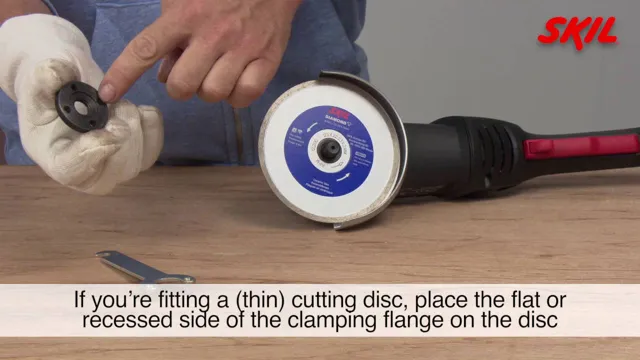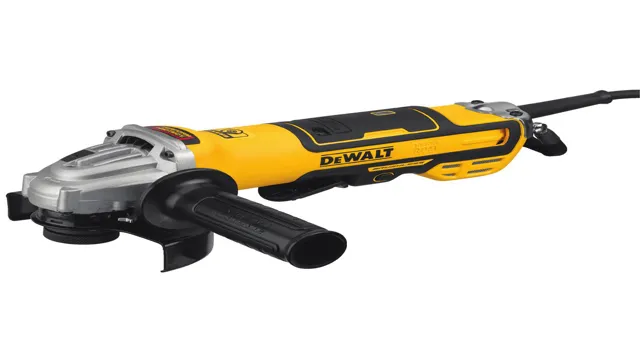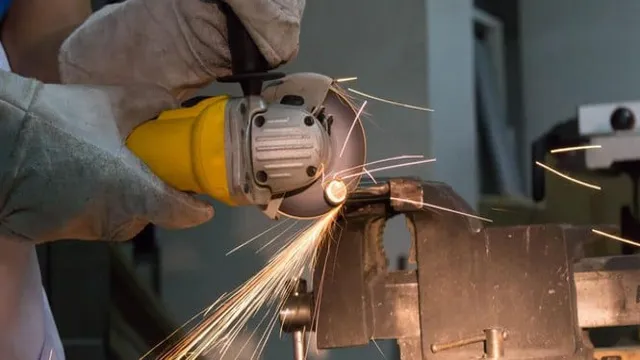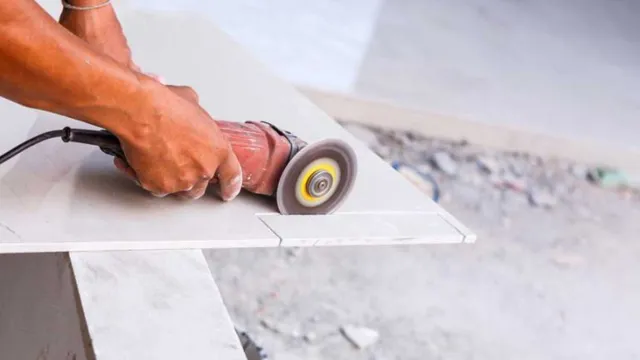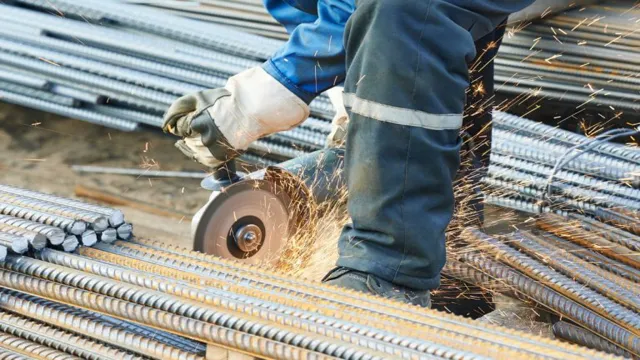How to Use a 9 Inch Angle Grinder Safely and Effectively – Tips and Tricks

When it comes to heavy-duty grinding or cutting tasks, the 9 inch angle grinder is the go-to tool for many professionals and DIY enthusiasts. But, using this powerful tool can be quite intimidating, especially for first-time users. From selecting the right blade to using the correct techniques, there are several factors to consider to ensure your safety and the success of your project.
In this blog, we will guide you through the basics of using a 9 inch angle grinder and share some tips and tricks to make the most out of this versatile tool. Whether you want to cut through metal, concrete or tiles, we’ve got you covered. Plus, we’ll also provide some insights on how to maintain your angle grinder in top shape, so you can continue to use it safely and effectively.
So, if you’re ready to learn everything you need to know about using a 9 inch angle grinder, let’s dive right in!
What is a 9 Inch Angle Grinder?
If you are looking to participate in some heavy-duty tasks, then a 9 inch angle grinder would definitely be a useful tool to have in your arsenal. This powerhouse tool is perfect for cutting and grinding hard materials such as steel or concrete, making it a great option for construction workers, metal fabricators, and DIY enthusiasts. Using a 9 inch angle grinder requires some skill and safety precautions, so it is important to start by reading the owner’s manual and wearing protective gear such as goggles and gloves.
Also, ensure that the material you are working on is secure and stable. Finally, it is essential to hold the grinder with both hands and use a slow and steady pace to avoid accidents. With some practice, you will be able to master the use of a 9 inch angle grinder and complete your tasks with ease.
Overview of Parts and Features
A 9 inch angle grinder is a versatile tool that can handle a wide variety of grinding and cutting tasks. It is typically used in construction and metalworking, but it’s becoming increasingly popular among DIY enthusiasts due to its power and flexibility. The most recognizable part of a 9 inch angle grinder is the abrasive disc, which is attached to the spindle that sits in the body of the tool.
The body of the grinder contains a motor that powers the disc, as well as a handle for easy maneuvering. Some advanced models come with additional features such as adjustable guards for increased safety, multiple speed settings, and different types of discs for enhanced functionality. Whether you’re grinding down metal, cutting through concrete, or removing rust and paint, a 9 inch angle grinder is an essential tool that can help you get your projects done quickly and efficiently.

Safety Precautions to Follow
When working with a 9 inch angle grinder, following safety precautions is essential to prevent accidents and injuries. First and foremost, always wear appropriate personal protective equipment such as safety glasses, sturdy work gloves, and a dust mask. Make sure the grinder is properly grounded and that the power source is adequate for the tool.
Additionally, inspect the grinder and its accessories before use for any signs of damage or wear. Always use the guard provided and ensure it is properly secured in place. When grinding, keep both hands on the tool and avoid reaching over the spinning disk.
It is also important to work in a well-ventilated area and avoid grinding near flammable materials or combustible dust. Taking these safety precautions can prevent serious injury and ensure a successful and safe project when using a 9 inch angle grinder.
Eye Protection and Face Shield
When it comes to eye protection and face shields, safety should always be a top priority. It’s essential to follow a few precautions to ensure that you’re properly protecting your eyes and face from any potential hazards. One of the most crucial steps you can take is to invest in the right type of eye protection, such as safety goggles or glasses that meet the appropriate safety standards.
Additionally, when using face shields, it’s important to choose ones that provide adequate coverage and are durable enough to withstand potential impact. Regular maintenance and cleaning of eye protection and face shields are also important to ensure their effectiveness. By taking these simple precautions, you can significantly reduce the risk of eye and face injuries while on the job or participating in other activities that involve potential hazards.
Stay safe and give your eyes and face the protection they deserve!
Ear Protection
Ear protection is of utmost importance in several professions and environments where noise levels are high. Industrial workers, musicians, construction workers, and shooting-range personnel are all susceptible to damaging their hearing if they do not take proper precautions. One effective method of ear protection is the use of earplugs or earmuffs.
Earplugs can be made out of foam or silicone and come in different shapes and sizes, whereas earmuffs are designed to cover the entire ear and block out noise. Both are equally effective and provide a comfortable fit when chosen correctly. It is imperative to read the manufacturer’s instructions and select ear protection that is appropriate for the level of noise exposure.
Instances of hearing loss or ear damage due to high levels of noise can be irreversible, so it is better to err on the side of caution and wear ear protection when necessary. By doing so, one can prevent long-term hearing complications and enjoy better hearing health.
Gloves and Long Sleeves
When it comes to protecting ourselves, gloves and long sleeves can go a long way in keeping us safe from harm. Whether you’re doing some yard work or handling chemicals, it’s important to take precautions to avoid any injuries or accidents. Wearing gloves can prevent cuts, scrapes, and burns, while long sleeves can provide an extra layer of protection against harmful substances or sharp objects.
However, it’s important to choose the right type of gloves and sleeves for the task at hand. For example, you wouldn’t want to wear cotton gloves when handling chemicals as they may not provide adequate protection. Instead, you should opt for specialized gloves made from materials such as nitrile or latex.
Similarly, you should choose sleeves made from durable materials such as Kevlar if you’re working with sharp tools or machinery. By taking these safety precautions, you can reduce the risk of injury and stay safe while carrying out your tasks.
Secure Your Workpiece
When working with power tools and machinery, it is crucial to secure your workpiece to prevent accidents and injuries. There are several safety precautions you can take to ensure your workpiece stays in place while you work. One of the easiest ways to do this is to use clamps or a vice to secure your workpiece firmly in place.
Be sure to select a clamp or vice that is appropriate for the size and shape of your workpiece and always use them in accordance with manufacturer instructions. Another important consideration is to wear appropriate safety gear, such as goggles and gloves, to protect yourself from flying debris or accidental contact with sharp edges. Remember, taking the time to secure your workpiece before you begin working can save you from serious harm down the line.
Stay safe and happy woodworking!
Positioning Yourself and the Grinder
When it comes to using a grinder, one of the most important things you can do is follow proper safety precautions. The grinder should always be positioned in a stable position, and you should make sure that the wheel guard is in place. Additionally, you should avoid wearing loose clothing or jewelry that could get caught in the grinder.
Eye protection is also a must, as flying debris can cause serious harm. Always inspect the grinder prior to use and make sure that it is in good condition, with no cracks or damage to the wheel. And never forget to disconnect the power source before making any adjustments to the grinder.
By following these safety precautions, you can help prevent accidents and keep yourself safe while using the grinder.
Step-by-Step Guide to Using a 9 Inch Angle Grinder
If you’re new to using a 9 inch angle grinder, don’t worry, it’s not as daunting as it may seem. Here’s a step by step guide to get you started. First, make sure you have all the necessary safety gear, including ear protection, eye protection, and gloves.
Next, double check that the disc is properly installed and secured. Now you can plug in the angle grinder and turn it on. Begin with light pressure until you get the hang of it, and always angle the tool away from yourself and others.
When you’re finished, turn off the grinder and unplug it before removing the disc. With practice and patience, using a 9 inch angle grinder can become a breeze.
Insert the Appropriate Disc
When it comes to using a 9 inch angle grinder, it’s important to ensure that you insert the appropriate disc for the job at hand. Different discs are designed for different applications, so it’s crucial to select the right one for the task you’re undertaking. For instance, if you’re cutting metal, you’ll need a cutting disc that’s specifically designed for metal.
Similarly, if you’re grinding concrete, you’ll need a diamond disc that’s capable of handling the tough material. Using the wrong disc can not only yield poor results, but it can also be dangerous. So always check the manufacturer’s guidelines and choose the right disc accordingly.
By doing so, you can ensure that your 9 inch angle grinder operates safely and efficiently, while delivering the results you desire.
Connect the Grinder to a Power Source
Once you have your 9 inch angle grinder set up and ready to go, the next step is connecting it to a power source. This can be done by finding a suitable outlet or generator that can handle the power requirements of the grinder. It’s important to double-check the voltage and amperage ratings of both the grinder and the power source to ensure compatibility.
Once you’ve found a suitable power source, plug in the grinder and make sure the switch is in the off position before turning on the power. Always follow safety guidelines and wear protective gear, like safety glasses and gloves, when using power tools. With the grinder connected to a power source, you’re ready to move on to the next step in using your angle grinder.
Test Run the Grinder
If you’re looking to get some heavy-duty grinding done, a 9 inch angle grinder is your tool of choice. However, before you dive right in and start grinding away, it’s important to know the proper steps to take to ensure both your own safety and the success of your project. First, make sure to have the proper safety equipment on-hand, including eye and ear protection and a dust mask.
Next, attach the appropriate grinding wheel for your project and make sure it’s securely in place. Double-check the wheel guard to make sure it’s properly adjusted. Now it’s time to start the grinder, but make sure to have a firm grip on the handle and keep a stable stance.
Move the grinder in a back-and-forth motion while applying steady pressure, being careful not to grind too much material in one spot. Finally, once you’ve finished grinding, switch off the grinder and unplug it. Remember to always prioritize safety while using any power tool, and don’t forget to keep your grinder properly maintained for optimal usage.
Start the Grinding Process
When it comes to using a 9 inch angle grinder, the first step is to start the grinding process. Before doing so, it’s important to make sure that the grinder is properly secured and the disc is installed correctly. Once that’s taken care of, it’s time to turn on the grinder and get started.
It’s recommended to hold the grinder with both hands, one hand on the handle and the other on the body, to maintain control and stability. When grinding, it’s important to work slowly and steadily, allowing the disc to do the work without applying too much pressure. Depending on the task at hand, it may be necessary to use different types of discs.
For example, a diamond-tipped disc can be used for cutting through tough materials like concrete or metal while a grinding disc can be used for smoothing out surfaces. By following these steps and taking the necessary precautions, you can safely and effectively use a 9 inch angle grinder to tackle a variety of grinding tasks.
Adjusting the Grinder Settings
Adjusting grinder settings can be a bit tricky, but it is a crucial step when using a 9-inch angle grinder. The size of the disc, the job at hand, and the type of material being worked on all affect the type of adjustments you should make. Firstly, make sure your grinder is unplugged.
Next, loosen the nut that holds the wheel in place. Make adjustments to the protective guard as necessary before tightening the nut. Next, check the speed specified on the disc and ensure that your grinder is set to that speed.
Finally, adjust the grinder’s depth of cut based on the material being worked on. With these steps, you can avoid unnecessary damage to your grinder or the material you are working on. Remember, it takes practice to perfect the process of adjusting your grinder’s settings, so take your time, be patient and make the necessary adjustments to achieve optimal results every time you use your grinder.
Finishing and Clean Up
When you’re finishing up a project using a 9 inch angle grinder, there are a few things to keep in mind to ensure your safety and the best results possible. First, be sure to turn off your grinder and unplug it before you start cleaning up your workspace. Next, use a wire brush or hand-held vacuum to clean up any metal shavings or debris left from the grinding process.
It’s important to wear gloves and safety goggles to protect your hands and eyes while doing this. Finally, store your grinder in a safe and secure location, away from any moisture or dampness that could cause rust or damage to the tool. With these simple steps, you can keep your workspace clean and safe and your 9 inch angle grinder in good working condition for your next project.
Tips and Tricks to Improve Your Grinding
If you’re looking for ways to improve your grinding with a 9 inch angle grinder, there are a few tips and tricks that can come in handy. First and foremost, make sure you have a firm grip on the tool and that you’re using both hands to maneuver it. This will give you better control over the grinder and reduce the risk of accidents.
Additionally, make sure you’re using the right disc for the job at hand – a diamond-tipped disc is great for cutting through concrete, while a grinding disc can be used to smooth out rough surfaces. Another key tip is to work slowly and steadily, rather than rushing the job – this will help you avoid mistakes and ensure a smoother finish. With these tips in mind, you’ll be well on your way to mastering the art of grinding with a 9 inch angle grinder.
Maintaining the Angle Grinder
Angle Grinder Maintaining your angle grinder is essential to ensure that it functions properly and lasts a long time. One tip for keeping your grinder in tip-top shape is to clean it regularly. Dust and debris can build up inside the machine, causing it to overheat and become less effective.
Wiping it down with a cloth after each use and using compressed air to blow out any dust trapped in the crevices can help prevent this problem. Another trick is to use the right discs for the job. Different types of discs are available, each with a specific purpose, and using the wrong one can damage your grinder and result in poor performance.
Finally, make sure your grinder’s accessories are well-maintained. This includes replacing worn-out discs and sharpening blades regularly. With these tips in mind, you can improve your grinding and get the most out of your angle grinder.
Choosing the Right Abrasive Disc for Your Task
When it comes to grinding, choosing the right abrasive disc for the task is crucial for achieving optimal results. There are many factors to consider, such as the material being worked on, the desired finish, and the speed of the tool being used. One tip to improve your grinding is to use a coarse grit for heavy material removal and a finer grit for finishing and polishing.
Another trick is to keep the abrasive disc cool and avoid overheating, as this can cause the disc to wear out faster or even crack. Additionally, it’s important to match the abrasive disc to the type of grinder being used, such as a resin bond for wet grinding or a ceramic bond for dry grinding. By taking these factors into consideration, you can ensure that you are using the right abrasive disc for your task and achieve a high-quality finish every time.
Using a Guide for Precision Grinding
Precision Grinding Precision grinding is a delicate and complex process that requires patience, skill, and accuracy. Utilizing a guide for precision grinding can be a valuable tool in improving your grinding technique. By following a guide, you can learn tips and tricks for achieving consistent results, minimizing errors, and producing high-quality products.
One important tip is to ensure that your grinding wheel is properly aligned with the surface you are working on. This can help prevent uneven wear and damage to the wheel, as well as improve the accuracy of your grinding. Another important aspect of precision grinding is selecting the right abrasive for the job.
Different abrasives have different properties, and choosing the right one can make a significant difference in the quality of your grinding. Other tips to consider when using a guide for precision grinding include maintaining consistent pressure throughout the grinding process and using a steady hand to guide the grinding wheel. You should also be aware of the speed of your grinding wheel, as grinding too quickly can result in overheating and damage to the wheel.
Overall, using a guide for precision grinding can help you improve your technique, achieve consistent results, and produce high-quality products. With patience and skill, you can master this delicate and complex process and take your grinding to the next level.
Avoiding Common Mistakes When Grinding
Grinding is an essential process in many industries, but it’s also one that can lead to mistakes if not done correctly. To improve your grinding, it’s crucial to understand some tips and tricks that can help you avoid common mistakes. Firstly, always make sure to use the right grinding wheel for the job.
Using the wrong wheel can cause damage to the workpiece and result in a poor finish. Secondly, it’s crucial to choose the right speed for your grinding process. Grinding too fast or too slow can lead to inadequate results or damage to the workpiece.
Another essential tip is to ensure you maintain proper coolant levels during the entire grinding process. Lastly, always make sure to wear the right personal protective equipment, such as goggles and gloves, to keep you safe from any debris. By following these tips, you can achieve better results in your grinding process and avoid common mistakes.
Remember to always put safety first and take your time to ensure you get the job done correctly.
Conclusion and Final Thoughts
Congratulations, you are now ready to wield your 9 inch angle grinder with finesse! Remember to always prioritize your safety, take note of the manufacturer’s suggestions, and make sure to handle it with respect. Whether you’re a professional handyman or a DIY enthusiast, this versatile tool will prove to be an asset in your arsenal. So go ahead, cut, grind, polish, and let your creativity soar with your trusty 9 inch angle grinder! Just don’t forget to wear safety glasses.
“
FAQs
What safety precautions should be taken when using a 9 inch angle grinder?
Always wear appropriate protective gear, such as safety glasses and gloves, and make sure the work area is clear of debris. Use the grinder on a stable surface and ensure the power supply is secured.
Can a 9 inch angle grinder be used for cutting materials other than metal?
Yes, a 9 inch angle grinder can be used for cutting a variety of materials including tile, brick, concrete, and masonry. However, be sure to use the appropriate blade for the material you are cutting.
How do I change the disc on my 9 inch angle grinder?
Unplug the grinder and use the locking pin and spanner wrench provided to remove the old disc. Insert the new disc and tighten it using the same tools.
Can a 9 inch angle grinder be used for sanding?
Yes, a 9 inch angle grinder can be used for sanding with the appropriate sanding disc attachment. Be sure to use a lower speed setting and apply even pressure to prevent damage to the material being sanded.
What is the recommended RPM for a 9 inch angle grinder?
The recommended RPM for a 9 inch angle grinder is typically in the range of 6,000 to 8,000 RPM, but consult the manufacturer’s instructions for your specific model.
How do I maintain my 9 inch angle grinder?
Regularly clean the tool and check for any damage or wear. Replace any worn or damaged parts and keep the tool lubricated as recommended by the manufacturer.
Can a 9 inch angle grinder be used for polishing?
Yes, a 9 inch angle grinder can be used for polishing with the appropriate polishing pad attachment. Be sure to use a lower speed setting and work in a circular motion to achieve a smooth finish.


